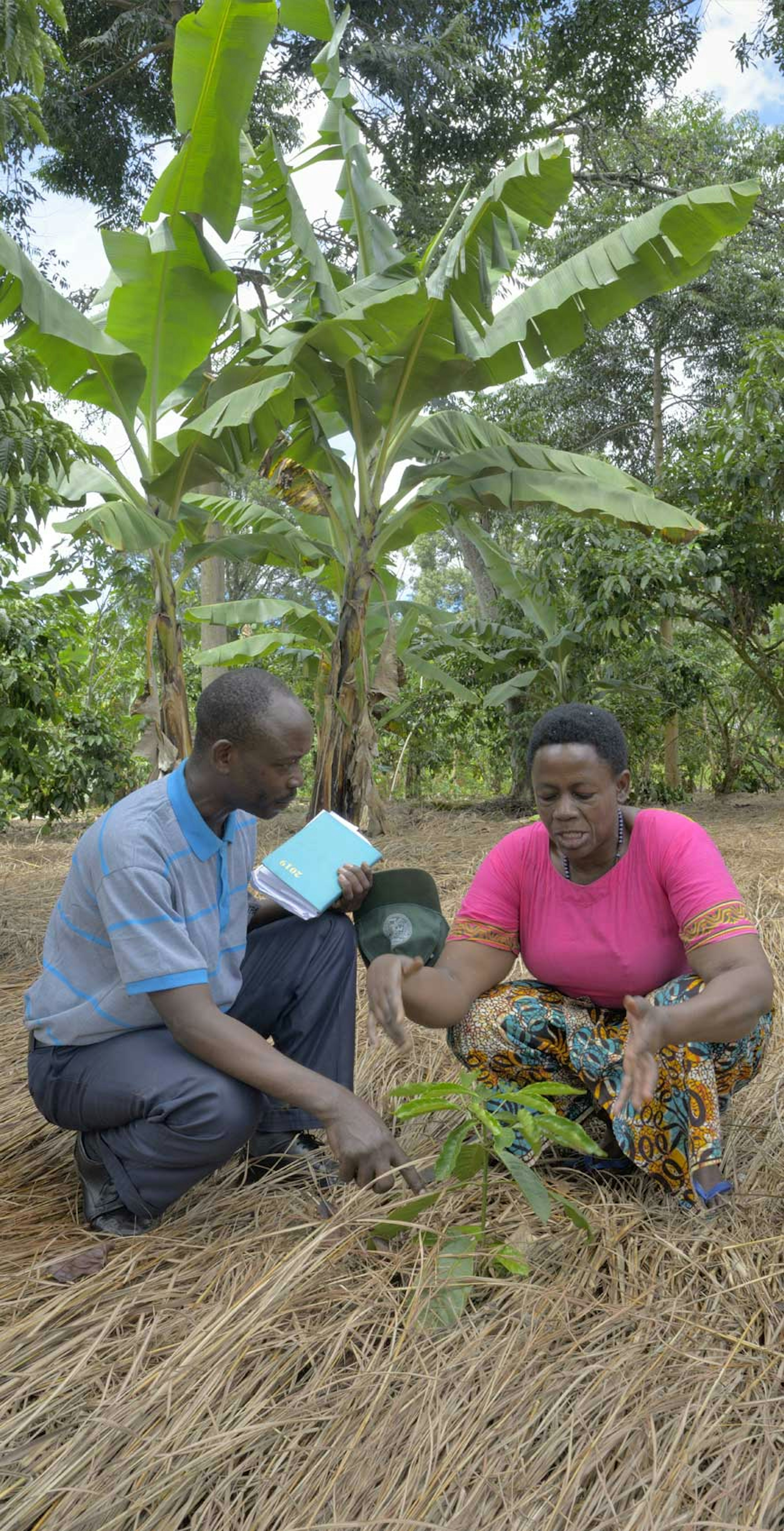Salient Issue
Water & Biodiversity
About 70 percent of the freshwater withdrawn for human use is directed toward agriculture, reducing the availability of water for people, animals and other plants. Farming can also have significant adverse impacts on biodiversity, where agrochemicals cause pollution or deforestation changes natural habitats, weather patterns or the water cycle.
Water consumption is particularly high in cotton, rice and sugar cane; these thirsty crops often require intensive irrigation. Rice production – concentrated primarily in Southern and Southeastern Asia – uses around 40% of the world’s irrigation water. Per one kilogram of crop produced, typical water consumption for cotton, rice and sugar cane exceeds 7 thousand, 3 thousand and 1,5 thousand litres, respectively.
The production of wine, flowers, bananas, and several other fruit and vegetable varieties are also water intensive. Local water shortages have been blamed on flower farms in Ethiopia, Kenya and Ecuador. In Chile, water scarcity is severe in regions where wine grapes and fruit are grown. In Peru’s Ica Valley, where farmers produce high volumes of fruits and vegetables for export, communities only have access to water for a few hours a week. In Mexico, avocado-related water extraction has reportedly opened up subsoil caverns that may increase the risk of earthquakes.
Waterways and land may be polluted by water from pesticide-treated fields or water used for processing if insufficiently treated. Documented cases of water pollution abound from across the world and in numerous commodities. Runoff from coffee processing in Central America affects the water and soil quality for neighbouring communities. Banana plantations along the Caribbean coast have damaged estuaries and coral reefs. Wastewater from textile factories in India, China and Indonesia have affected local fish and shrimp populations.
Gold mining also damages soil, air and waters with the spread of toxic wastes, including mercury, arsenic and cyanide.
Biodiversity is at highest risk in areas of high density monocropping. Monocultures reduce biodiversity both in the crop area and in the surrounding areas, because fertilizer and pesticide use is typically high. Pesticide application can contaminate surrounding land, waterways and human habitats.
It is estimated that less than 1% of the pesticides applied on flower farms and banana plantations reach their target, leaving the rest to pollute the local environment. Most of the world’s coffee and tea is also produced in monocultures with a high use of agrochemicals.
Deforestation reduces habitats and changes microclimates, which can further reduce biodiversity. Full-sun cocoa production in West Africa has spurred deforestation and drastic reduction of habitats for a number of animals, from chimpanzees to elephants and flying squirrels.
In coffee and tea production, climate change is increasingly pushing farmers to shift production to higher elevations where climate is still suitable. This propels further deforestation.

According to a longitudinal study on banana production in Peru
Despite global challenges, Fairtrade banana producers in Peru had increased their environmental awareness, improved soil quality, implemented organic practices and reduced waste.

Action
Fairtrade's response
Fairtrade certified organisations work in many tropical areas with a high biodiversity value. The two countries with the highest number of Fairtrade certified organisations, Peru and Kenya, are biodiversity hotspots.
Agriculture relies on many services provided by biodiversity, including pollination, groundwater and a stable microclimate. Smallholder agriculture can be very biodiversity-friendly, as it eschews large monocultures and often maintains diverse crops, vegetation and habitats.
Fairtrade encourages and incentivises organic production and agroecological measures with a focus on soil health, decreased use of agrochemicals, and a reduced water and carbon footprint.
Among Fairtrade’s salient issues, biodiversity is the area with the clearest need for stronger policies and activities. To achieve this, Fairtrade has adopted a global strategy for climate and environmental work.

According to research
Compared to other cocoa farmers in Ghana, Fairtrade farmers showed a higher understanding of environmental topics.
Fairtrade's response in detail
1. Preventive and mitigating measures
Fairtrade utilises a variety of tools to maintain and protect biodiversity and water sources at farm and plantations level. The Fairtrade Standards are one of these tools. They include several requirements related to biodiversity and water, including:
- Prohibition of most harmful agrochemicals. Fairtrade certified farmer organisations, plantations and traders must maintain a list of pesticides used on their own or their members’ fields, refrain from using chemicals on Fairtrade International’s Red List of prohibited chemicals and implement a plan for reducing the use of chemicals listed as Orange.
- Reduced use of agrochemicals. To reduce pesticide and herbicide use, Fairtrade certified plantations are required to monitor main pests, consult external experts, and utilise alternative ways for controlling pests and weeds. Certified farmer organisations are encouraged to train their members on alternative methods of pest management and weed prevention. To reduce risks related to fertilisers, plantations are to store them safely and only apply them in amounts that correspond to the nutrient need of the crop.
- Buffer zones. Plantations need to maintain buffer zones around water bodies, human habitats and protected areas, where agrochemicals are not used, to protect biodiversity and people’s health.
- Sustainable water use. Both plantations and farmer organisations need to identify the source of irrigation water. Plantations must also implement procedures to make efficient and rational use of water sources. Further, where local water resources are strained, plantations are encouraged to engage with authorities or local initiatives to find solutions to water shortages.
- Waste management. Plantations must establish a waste management plan that includes strategies and timelines for waste reduction, recycling, reuse and disposal alternatives. Farmer organisations are encouraged to train members to reuse organic waste.
- Protecting plants and animals. Wild harvesting of Fairtrade products must not endanger the survival of the collected species, rare or endangered species must not be collected, and invasive species must not be introduced.
- The updated Fairtrade Standard for Hired Labour Organisations includes robust requirements on the environment and biodiversity.
Please see the page on climate change for further information. In total, environmental criteria account for about one third of all requirements for both farmer organisations and plantations. In recent years, Fairtrade has expanded the number and scope of environmental criteria for all farmer organisations, and particularly for those producing coffee or cocoa. The new criteria for cocoa and coffee are aligned with the EU Deforestation regulation, and they entail deforestation monitoring measurements, and additional investments from supply chain actors to tackle root causes of deforestation. The revision of the Fresh Fruits and Vegetable standard is undergoing.
Obviously, standards requirements and auditing are insufficient to address biodiversity loss and water risks. This is why Fairtrade also addresses these issues and their root causes in a range of other ways:
- Training on good agricultural practices, including biodiversity conservation and sustainable management of water resources, is increasingly offered to farmer organisations and plantations. These trainings, organised by Fairtrade Producer Networks in Africa, Asia and Latin America, raise farmer awareness on how farming practices relate to environmental problems, for example how the clearing of forested land can decrease crop pollination. A study has shown mixed results regarding farmer organisations’ awareness and performance on biodiversity issues.
- Projects can help strengthen good agricultural practices in high-risk areas. In total, Fairtrade Impact map presents eleven ongoing projects related to environment, climate, biodiversity and land management. The Sankofa 2.0 project, for example, combines measures to promote biodiversity, diversify incomes, and promote dynamic agroforestry among cocoa farmers in Ghana. Farmers are encouraged to stop burning organic matter and to reduce the use of agrochemicals. The project benefits roughly 2 900 cocoa farmers and is supported by a Fairtrade cocoa processor HALBA, who also pays the living income reference price for the cocoa.
- Collaboration among supply chain actors. Fairtrade promotes and facilitates collaboration, encouraging retailers, brands and traders to co-invest in environmental projects.
- Multistakeholder collaboration. Fairtrade is increasingly participating in environmental collaboration. For example, Fairtrade participated in the development of OECD/FAO's Deforestation Due Diligence Handbook and co-founded a Food for Biodiversity initiative in Germany.
- Partnerships. Fairtrade has ongoing collaboration with many environmental organisations, including International Union for Conservation of Nature - IUCN, Alliance of Biodiversity International - CIAT and Satelligence, who supports our deforestation monitoring. Regarding food system transformation, Fairtrade is an active member of the True Value of Food initiative.
- Advocacy work. In 2022, Fairtrade adopted a policy on sustainable agriculture that recommends the agroecological approach. Before COP15 in Montreal in 2022, Fairtrade made several requests, including: economic incentives to reward biodiversity-friendly production, participation of smallholder farmers in decision-making on biodiversity laws and policies, support measures for transitioning to agroecology, a ban on the use and export of toxic pesticides, and improved monitoring of biodiversity loss in the agricultural sector. To address the root causes of biodiversity loss, Fairtrade advocates for legislation and binding international treaties on climate change, bringing in the perspective of smallholder farmers. For example, in the negotiations on EU Deforestation Regulation, Fairtrade highlighted the needs of cocoa and coffee smallholders.
At the export, import and manufacturing stages, Fairtrade’s environmental interventions are laid out in the Fairtrade Trader Standard. This Standard requires companies to be aware of applicable legislation on land use, biodiversity, use of water and wastewater, and show no evidence of violations. The new Fairtrade Trader Standard includes requirements on HREDD, such as managing environmental impacts. Compliance with these requirements is checked in audits if there are any prior indications of non-compliance1.
In addition, traders must comply with Fairtrade’s pricing and Premium requirements, which allow farmer organisations and plantations to invest in environmental sustainability.
1: Indications can be obtained e.g. via allegations made by third parties or via observations during trader audits.
2. Remediating measures
Every human being has a right to a clean, healthy and sustainable environment. This was confirmed by the General Assembly of the United Nations on 26 July 2022.
However, it can be difficult to identify responsible violators of this human right, particularly in cases of gradual change in the environment. In such cases, it is still rare for victims whose lives are impacted by biodiversity loss to gain remediation2 Where direct remediation efforts are not possible, Fairtrade seeks to prevent and mitigate3 its impact on biodiversity and water.
Loss of biodiversity affects farmers, farm workers and their communities in many ways. Their livelihoods are strongly dependent on thriving biodiversity and healthy habitats and ecosystems. Decreases in biodiversity have an adverse impact on their rights to food, clean air and water, health, culture, and even the right to life4.
As stated in Fairtrade’s policy for sustainable agriculture, Fairtrade protects forests, ecosystems, natural areas, and protected areas, and works against the unsustainable exploitation of these by implementing sustainable yield practices and remote sensing technology, such as using satellite or aerial data to monitor environmental conditions. Fairtrade promotes the efficient use of water resources and the adoption of practices enhancing water retention, water quality, re-use of water and the general reduction of water consumption for production.
Fairtrade’s primary approach to reducing the adverse impacts of biodiversity loss begins with evaluating the biodiversity performance of production under Fairtrade terms. Secondly, through its partnership and project implementation, Fairtrade accelerates agroecology transitions to regenerate ecosystems and improve the economic conditions of producers and workers. Fairtrade policies are aligned with the Principles of Agroecology defined by FAO.
Agroecological practices, including regenerative methods, can generate essential ecosystem services by maintaining biodiversity across agricultural lands and increasing connectivity for biodiversity. There is no evidence that diversified production systems compromise food security. On the contrary, many agricultural diversification practices provide multiple complementary benefits, as confirmed by a recent Fairtrade-commissioned study. Fairtrade also prioritises soil quality and good capacities in this area have been recorded, for example in coffee and banana cultivation.
Fairtrade aims to address deforestation through partnerships. As a member of the ISEAL Alliance, Fairtrade actively participates in traceability learning and the deforestation coordination group. Partnering with Satelligence, Fairtrade has accurate monitoring data on deforestation in its supply chains. Additionally, Fairtrade collaborates closely with the Cocoa Coalition on deforestation issues.
2: Remediation refers to the process of counteracting or fixing a human rights violation through measures that can include apologies, restitution, rehabilitation, financial or non-financial compensation, and punitive sanctions, as well as preventing the repetition or further cases of harm (UNGP Interpretive Guide, p. 12).
3: Mitigating measures reduce the likelihood of an adverse impact (UNGP Interpretive Guide, p. 12)
4: UNEP and OHRHR, 2021 Human Rights & Biodiversity

According to research in Belize
Fairtrade allows sugar farmers’ associations to better provide agronomic and environmental services to their members.
Evaluation of Fairtrade sugar in Belize, 2022, page 61.